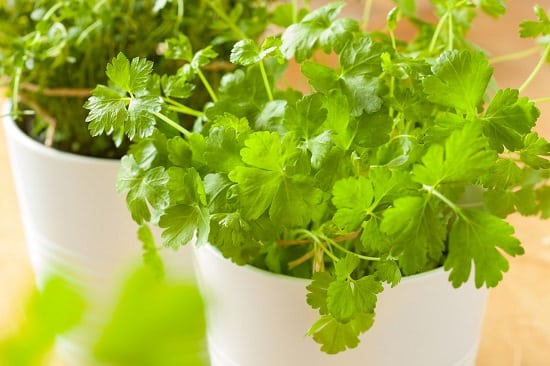Cilantro vs. Parsley: A debate that never seems to end. Read on to know the difference between these two herbs and never get confused again!
Cilantro and Parsley are two herbs that you can grow in your garden, porch, or balcony, with ease. But if you don’t know much about herbs, then it’ll be difficult to tell them apart, since these two look similar. Therefore, reading this Cilantro vs. Parsley guide is important to learn how to differentiate them!
Want to grow cilantro in pots? Click here!
Difference Between Parsley and Cilantro

Here are some of the key differences between both:
1. Family

Cilantro and parsley both belong to the same family Apiaceae. The difference in Cilantro vs.Parsley is-the Coriandrum sativum (Cilantro) is an annual herb, Petroselinum crispum (Parsley) is a biennial herb.
To learn how to grow parsley in pots, click here!
2. Appearance
It is one of the key differentiating factors in Cilantro vs.Parsley. Parsley can be broadly classified into two types–Curly and Flat-leaf. It is easy to distinguish curly leaf parsley from cilantro as the former has thick, ruffled leaves. You can also tell them apart by flat-leaf parsley’s pointy leaves.
You can tell cilantro apart from flat-leaf parsley by its rounded leaves. Also, the leaves of Fresh parsley are bright green in color as compared to cilantro, which can also be a differentiating factor.
3. Smell

Another way to know the difference between them is by taking a whiff. Cilantro possesses a strong fragrance as compared to parsley, and it’s also evident in both aroma and flavor. In fact, parsley (especially, the curled leaf) is so mild that you’ll hardly notice its absence from the dish.
4. Flavor
Just like the fragrance, cilantro also leads in the flavor. It has an intense and earthy flavor. Add a little too much of cilantro, and it’ll ruin your dish with excess flavor. While parsley is mild and brings a fresh, peppery and spicy flavor to the table, cilantro brings a strong flavor resembling a mix of lemon and sage.
5. Cuisines
Another factor in Cilantro vs. Parsley is the cuisines they go well with. Mediterranean and Italian dishes have parsley incorporated into them frequently. You can use parsley in pasta, stews, salads, smoothies, soups, and even juices.
When it comes to cilantro, it’s commonly found in Indian and Mexican cuisines. Common Mexican dishes like salsa or tacos have cilantro in them, Indian dishes like curries and veggies have it! In China, where parsley is called Chinese parsley, it’s sprinkled over curries or pho. While both are used as garnishes over dishes, cilantro is often added to the dish after it’s cooked, while the flat-leaf parsley is mostly used during the cooking process.
Also Read: Difference between Cilantro and Culantro
6. Health Benefits

Cilantro and parsley have Vitamin A and C in abundance. Both are good for bone health and faster healing of wounds because of the presence of vitamin K. Both reduce blood sugar levels but with different processes.
Parsley is rich in antioxidants and anti-inflammatory in nature, which lowers insulin resistance. Cilantro works by increasing the enzyme activity, processing the sugar at a faster rate. Apart from keeping blood sugar in check, cilantro also has a detoxifying effect on the body. Parsley, on the other hand, aids in digestion, improves immunity and concentration.


